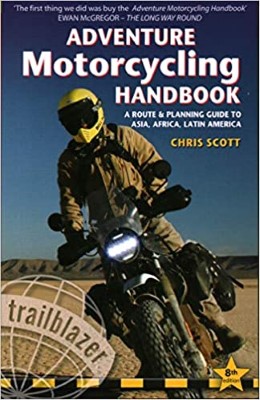 11Likes 11Likes
 |

11 Nov 2017
|
|
Registered Users
Veteran HUBBer
|
|
Join Date: Apr 2005
Location: Oxford UK
Posts: 2,120
|
|
Quote:
Originally Posted by eurasiaoverland

Hi
My usual problem in cold climates is my lower back. I'm thin but relatively tall, so clothes are invariably either too baggy or a bit too short. I've got down salopettes as an outer layer, which come right up my back, but are there any products which specifically protect your lower back / kidneys? Something like a gaiter?
Thanks for any help,
EO
|
I presume you've looked at regular kidney belts. If not then Google will show you as many as you'd want to see. Many bikers use them for lower back support but they do keep the area warm as a byproduct. You don't need a kind of Victorian whalebone ex Dakar version (you won't be able to bend over), just something padded, elastic and velcro fastened. Mine was a few pounds in Lidl many years ago and still works fine. I only ever feel the need to use it these days when the wind chill temp is heading south of -10C
Far be it for me to offer advice on surviving in -40C temps but when it comes to a choice of the "warmest material which is insulating, yet thin enough so I don't lose too much dexterity", might I suggest fat. As you're "thin but relatively tall" an extra few kilos gained through burgers, pies and a good Christmas might keep Jack Frost's freezy fingers at bay a little longer. There is some (rudimentary) scientific evidence for this - https://www.popsci.com/article/scien...er-thin-people but whether it would make much difference in practice I've no idea.
|

11 Nov 2017
|
|
Registered Users
Veteran HUBBer
|
|
Join Date: Oct 2014
Location: Brunei
Posts: 979
|
|
Quote:
Originally Posted by backofbeyond

I presume you've looked at regular kidney belts. If not then Google will show you as many as you'd want to see. Many bikers use them for lower back support but they do keep the area warm as a byproduct. You don't need a kind of Victorian whalebone ex Dakar version (you won't be able to bend over), just something padded, elastic and velcro fastened. Mine was a few pounds in Lidl many years ago and still works fine. I only ever feel the need to use it these days when the wind chill temp is heading south of -10C
Far be it for me to offer advice on surviving in -40C temps but when it comes to a choice of the "warmest material which is insulating, yet thin enough so I don't lose too much dexterity", might I suggest fat. As you're "thin but relatively tall" an extra few kilos gained through burgers, pies and a good Christmas might keep Jack Frost's freezy fingers at bay a little longer. There is some (rudimentary) scientific evidence for this - https://www.popsci.com/article/scien...er-thin-people but whether it would make much difference in practice I've no idea. |
Thanks for the advice, I'll search for kidney belts.
As for gaining weight, that is precisely my plan, though it is not something I can do easily (going to a gym is out of the question). I will keep at it nonetheless!
Cheers
EO
__________________
EurasiaOverland a memoir of one quarter of a million kilometres by road through all of the Former USSR, Western and Southern Asia.
|

12 Nov 2017
|
 |
R.I.P.
Veteran HUBBer
|
|
Join Date: Aug 2003
Location: california
Posts: 3,824
|
|
Are you walking or driving across Russia?  My advice? Stay in the frickin truck! 
If you like to camp, then since you've got a truck, bring Li-Iron batteries and plug them into heated gear when in your tent ... or be smart enough to bring a truck/Van you can sleep in.
It's so easy. Next day, charge them back up when on the move from truck elec. system. It's basic.
I spent 2 years in Antarctica with US Antarctic program. I did field party support on several occasions. Temps were only minus 20F. we used cots in the tent to stay UP off the ice.
We also got Crevasse rescue training from Brit Antarctic Survey guys. Luckily never needed to try it out.
If you plan to hike for days away from your truck ... we'll, you better leave that truck someplace SAFE ... or it will be stolen and stripped in 10 minutes.
So, stay in or near your truck ... and when you want a real adventure ... get on a bike and try it. 
|

12 Nov 2017
|
|
Registered Users
Veteran HUBBer
|
|
Join Date: Oct 2014
Location: Brunei
Posts: 979
|
|
Did you read my original post? I was asking about clothing.
Quote:
Originally Posted by mollydog

Are you walking or driving across Russia?  My advice? Stay in the frickin truck!  Understand that it is necessary to leave the vehicle to, for example, fill it with fuel, enter a nearby building, relieve one's self and many, many other activities. Also to have a chance of surviving until another vehicle comes past in case of getting stuck or breaking down
Understand that it is necessary to leave the vehicle to, for example, fill it with fuel, enter a nearby building, relieve one's self and many, many other activities. Also to have a chance of surviving until another vehicle comes past in case of getting stuck or breaking down
If you like to camp, then since you've got a truck, bring Li-Iron batteries and plug them into heated gear when in your tent ... or be smart enough to bring a truck/Van you can sleep in.
I'm one step ahead of you here, I have a heated sleeping area.
It's so easy. Next day, charge them back up when on the move from truck elec. system. It's basic.
I spent 2 years in Antarctica with US Antarctic program. I did field party support on several occasions. Temps were only minus 20F. we used cots in the tent to stay UP off the ice.
We also got Crevasse rescue training from Brit Antarctic Survey guys. Luckily never needed to try it out.
If you plan to hike for days away from your truck ... we'll, you better leave that truck someplace SAFE ... or it will be stolen and stripped in 10 minutes.
I doubt there are many people lurking in the wilderness in -40ºC or less waiting for someone to park up their car and go off hiking into the frozen darkness. Frankly I'd be far more concerned that the engine wouldn't start until spring due to the cold.
So, stay in or near your truck ... and when you want a real adventure ... get on a bike and try it.  Thank you for your expert advice. I'll stick to a heated vehicle.
Thank you for your expert advice. I'll stick to a heated vehicle. |
__________________
EurasiaOverland a memoir of one quarter of a million kilometres by road through all of the Former USSR, Western and Southern Asia.
|

12 Nov 2017
|
 |
R.I.P.
Veteran HUBBer
|
|
Join Date: Aug 2003
Location: california
Posts: 3,824
|
|
Quote:
Originally Posted by eurasiaoverland

Did you read my original post? I was asking about clothing.
|
I get that.
Quote:
Originally Posted by eurasiaoverland

Thank you for your expert advice. I'll stick to a heated vehicle.
|
Of course you will ... please keep your fridge well stocked with good Beer to share with bike riders! 
|

14 Nov 2017
|
 |
Contributing Member
Veteran HUBBer
|
|
Join Date: Mar 2004
Location: Saltspring Island,Canada/Poole,UK
Posts: 1,081
|
|
Hi EO,
I worked on a Gondola rescue team here in Canada for 10+ years, outside in all weathers and down to below -40 C and lived in Banff Alberta for 10 years before moving to the coast.
The best clothing to wear for driving a vehicle is Icebreaker Merino wool layers - a couple of thinner long sleeve layers and one a little thicker with a wool jumper/sweater over the top with a down jacket and lined pants with merino long johns underneath.
Most Canadian workers/drivers/riggers who have to work outside in the winter wear these Helly Hansen coveralls:
https://www.marks.com/en/helly-hanse...Bcolor%5D=NAVY
We also used these on the Gondola rescue team, they are awesome when you are working outside and are very hard wearing and durable, they do not snag or rip like a down jacket. They are fleece lined inside and to be honest were too warm to wear unless the temperature was below about -5 C. For me they are too warm to wear whilst driving with a heater on and a little awkward inside a vehicle. But if you have to change a tyre or fit/remove snow chains, work outside they are perfect.
Gloves and hats: Id just try a few different ones, they are kind of a personal thing, some windproof/waterproof gloves and some thinner inner liners for dexterity, make sure they are windproof - the wind is what makes life difficult in the colder temperatures and make sure you have a few spare pairs of gloves for when you take one off and leave it somewhere.
For a Balaclava, make sure it covers your nose and lips and comes high up on you face under your eyes, good ones will have a small opening for you to breath out of your nostrils and thinner material over your mouth. At -45 C ish with some windchill you can get frost nip on exposed skin in a few minutes. Also a Polar Buff is a good piece of kit - lots of motorcyclists have a 'Buff' or something similar:
https://www.cotswoldoutdoor.com/p/bu...tml?colour=122
Outdoor research and Extremities make good quality gloves, balaclavas and hats IME. I would also take some clear or yellow tinted goggles in case you have to be out in the wind with snow blowing around.
If you need any more info let me know, hope that is helpful 
|

18 Nov 2017
|
|
Registered Users
Veteran HUBBer
|
|
Join Date: Oct 2014
Location: Brunei
Posts: 979
|
|
Great! This is exactly the response I was looking for and a big help in my preparation, thank you very much.
Those HH coveralls look good.. if space was no issue then I'd like to take a set along, however given that I already have my down outer layers, I can't quite justify them, even though they are much tougher in the event that I need to do some work on the car (hard to imagine being able to do much in -40 though!).
Now off to buy base layers, hat and gloves.
EO
Quote:
Originally Posted by Gipper

Hi EO,
I worked on a Gondola rescue team here in Canada for 10+ years, outside in all weathers and down to below -40 C and lived in Banff Alberta for 10 years before moving to the coast.
The best clothing to wear for driving a vehicle is Icebreaker Merino wool layers - a couple of thinner long sleeve layers and one a little thicker with a wool jumper/sweater over the top with a down jacket and lined pants with merino long johns underneath.
Most Canadian workers/drivers/riggers who have to work outside in the winter wear these Helly Hansen coveralls:
https://www.marks.com/en/helly-hanse...Bcolor%5D=NAVY
We also used these on the Gondola rescue team, they are awesome when you are working outside and are very hard wearing and durable, they do not snag or rip like a down jacket. They are fleece lined inside and to be honest were too warm to wear unless the temperature was below about -5 C. For me they are too warm to wear whilst driving with a heater on and a little awkward inside a vehicle. But if you have to change a tyre or fit/remove snow chains, work outside they are perfect.
Gloves and hats: Id just try a few different ones, they are kind of a personal thing, some windproof/waterproof gloves and some thinner inner liners for dexterity, make sure they are windproof - the wind is what makes life difficult in the colder temperatures and make sure you have a few spare pairs of gloves for when you take one off and leave it somewhere.
For a Balaclava, make sure it covers your nose and lips and comes high up on you face under your eyes, good ones will have a small opening for you to breath out of your nostrils and thinner material over your mouth. At -45 C ish with some windchill you can get frost nip on exposed skin in a few minutes. Also a Polar Buff is a good piece of kit - lots of motorcyclists have a 'Buff' or something similar:
https://www.cotswoldoutdoor.com/p/bu...tml?colour=122
Outdoor research and Extremities make good quality gloves, balaclavas and hats IME. I would also take some clear or yellow tinted goggles in case you have to be out in the wind with snow blowing around.
If you need any more info let me know, hope that is helpful  |
__________________
EurasiaOverland a memoir of one quarter of a million kilometres by road through all of the Former USSR, Western and Southern Asia.
|
|
Currently Active Users Viewing This Thread: 1 (0 Registered Users and/or Members and 1 guests)
|
|
|
 Posting Rules
Posting Rules
|
You may not post new threads
You may not post replies
You may not post attachments
You may not edit your posts
HTML code is Off
|
|
|
|

Check the RAW segments; Grant, your HU host is on every month!
Episodes below to listen to while you, err, pretend to do something or other...

2020 Edition of Chris Scott's Adventure Motorcycling Handbook.
"Ultimate global guide for red-blooded bikers planning overseas exploration. Covers choice & preparation of best bike, shipping overseas, baggage design, riding techniques, travel health, visas, documentation, safety and useful addresses." Recommended. (Grant)

Led by special operations veterans, Stanford Medicine affiliated physicians, paramedics and other travel experts, Ripcord is perfect for adventure seekers, climbers, skiers, sports enthusiasts, hunters, international travelers, humanitarian efforts, expeditions and more.
Ripcord Rescue Travel Insurance™ combines into a single integrated program the best evacuation and rescue with the premier travel insurance coverages designed for adventurers and travel is covered on motorcycles of all sizes.
(ONLY US RESIDENTS and currently has a limit of 60 days.)
Ripcord Evacuation Insurance is available for ALL nationalities.
What others say about HU...
"This site is the BIBLE for international bike travelers." Greg, Australia
"Thank you! The web site, The travels, The insight, The inspiration, Everything, just thanks." Colin, UK
"My friend and I are planning a trip from Singapore to England... We found (the HU) site invaluable as an aid to planning and have based a lot of our purchases (bikes, riding gear, etc.) on what we have learned from this site." Phil, Australia
"I for one always had an adventurous spirit, but you and Susan lit the fire for my trip and I'll be forever grateful for what you two do to inspire others to just do it." Brent, USA
"Your website is a mecca of valuable information and the (video) series is informative, entertaining, and inspiring!" Jennifer, Canada
"Your worldwide organisation and events are the Go To places to for all serious touring and aspiring touring bikers." Trevor, South Africa
"This is the answer to all my questions." Haydn, Australia
"Keep going the excellent work you are doing for Horizons Unlimited - I love it!" Thomas, Germany
Lots more comments here!

Every book a diary
Every chapter a day
Every day a journey
Refreshingly honest and compelling tales: the hights and lows of a life on the road. Solo, unsupported, budget journeys of discovery.
Authentic, engaging and evocative travel memoirs, overland, around the world and through life.
All 8 books available from the author or as eBooks and audio books
Back Road Map Books and Backroad GPS Maps for all of Canada - a must have!
New to Horizons Unlimited?
New to motorcycle travelling? New to the HU site? Confused? Too many options? It's really very simple - just 4 easy steps!
Horizons Unlimited was founded in 1997 by Grant and Susan Johnson following their journey around the world on a BMW R80G/S.
 Read more about Grant & Susan's story
Read more about Grant & Susan's story
Membership - help keep us going!
Horizons Unlimited is not a big multi-national company, just two people who love motorcycle travel and have grown what started as a hobby in 1997 into a full time job (usually 8-10 hours per day and 7 days a week) and a labour of love. To keep it going and a roof over our heads, we run events all over the world with the help of volunteers; we sell inspirational and informative DVDs; we have a few selected advertisers; and we make a small amount from memberships.
You don't have to be a Member to come to an HU meeting, access the website, or ask questions on the HUBB. What you get for your membership contribution is our sincere gratitude, good karma and knowing that you're helping to keep the motorcycle travel dream alive. Contributing Members and Gold Members do get additional features on the HUBB. Here's a list of all the Member benefits on the HUBB.
|
|
|